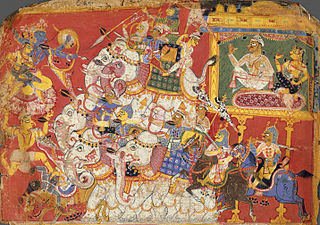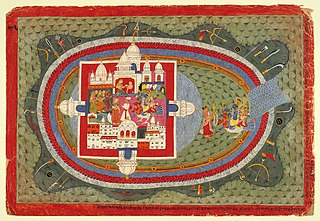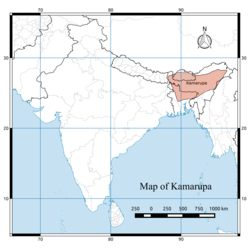
The Kamakhya Temple at Nilachal hills in Guwahati, Assam is one of the oldest and most revered centres of Tantric practices, dedicated to the goddess Kamakhya. The temple is the center of the Kulachara Tantra Marga and the site of the Ambubachi Mela, an annual festival that celebrates the menstruation of the goddess. Structurally, the temple is dated to the 8th-9th century with many subsequent rebuildings—and the final hybrid architecture defines a local style called Nilachal. It is also one among the oldest 4 of the 51 pithas in the Shakta tradition. An obscure place of worship for much of history it became an important pilgrimage destination, especially for those from Bengal, in the 19th century during colonial rule.

Kamarupa, an early state during the Classical period on the Indian subcontinent, was the first historical kingdom of Assam.

The history of Assam is the history of a confluence of people from the east, west, south and the north; the confluence of the Austroasiatic, Tibeto-Burman (Sino-Tibetan), Tai and Indo-Aryan cultures. Although invaded over the centuries, it was never a vassal or a colony to an external power until the third Burmese invasion in 1821, and, subsequently, the British ingress into Assam in 1824 during the First Anglo-Burmese War.

The Varman dynasty (350–650) was the first historical dynasty of the Kamarupa kingdom. It was established by Pushyavarman, a contemporary of Samudragupta. The earlier Varmans were subordinates of the Gupta Empire, but as the power of the Guptas waned, Mahendravarman (470–494) performed two horse sacrifices and the status of Kamarupa as an independent state remained unimpaired. As per the Apsad Inscription of Adityasen, Susthivarman was defeated by Mahasengupta on the bank of Lauhitya. The first of the three Kamarupa dynasties, the Varmans were followed by the Mlechchha and then the Pala dynasties.

The Mlechchha dynasty ruled Kamarupa from their capital at Harruppesvar in present-day Tezpur, Assam, after the fall of the Varman dynasty. According to historical records, there were twenty one rulers in this dynasty, but the line is obscure and names of some intervening rulers are not known. Like all other Kamarupa dynasties a semi-mythical lineage from Narakasura was constructed to accord legitimacy to their rule. The Mlechchha dynasty in Kamarupa was followed by the Pala kings. The dynasty is unrelated to the previous Varman dynasty.

The Khen dynasty of Assam was a late medieval dynasty of the erstwhile Kamata kingdom. After the fall of the Pala dynasty of Kamrupa, the western region was reorganized into the Kamata kingdom when Sandhya moved his capital from Kamarupanagara to Kamatapur in about 1257 due to the frequent clashes with the Kacharis from the east. Sandhya styled himself Kamateswara and the kingdom came to be known as "Kamata". The Khen dynasty at a later period took control of the kingdom.

The Kamata Kingdom emerged in western Kamarupa probably when Sandhya, a ruler of Kamarupanagara, moved his capital west to Kamatapur sometime after 1257 CE. Since it originated in the old seat of the Kamarupa kingdom, and since it covered most of the western parts of it, the kingdom is also sometimes called as Kamarupa-Kamata.

The Dimasa Kingdom was a late medieval/early modern kingdom in Assam, Northeast India ruled by Dimasa kings. The Dimasa kingdom and others that developed in the wake of the Kamarupa kingdom were examples of new states that emerged from indigenous communities in medieval Assam as a result of socio-political transformations in these communities. The British finally annexed the kingdom: the plains in 1832 and the hills in 1834. This kingdom gave its name to undivided Cachar district of colonial Assam. And after independence the undivided Cachar district was split into three districts in Assam: Dima Hasao district, Cachar district, Hailakandi district. The Ahom Buranjis called this kingdom Timisa.

The Bhauma dynasty is the second legendary dynasty of Pragjyotisha, after the Danava dynasty. Narakasura, who is said to have established this dynasty, and his descendants Bhagadatta and Vajradatta are first mentioned in the epics Mahabharata and the Ramayana in the sections that were composed in the first few centuries though they place them variously in either northwestern or eastern India. Narakasura's legend is further embellished in the locally composed Kalika Purana, the Yogini Tantra and local lores and the legends became firmly attached to Assam and North Bengal. The late embellishment of the Naraka legends point to legitimization of the three dynasties of the Kamarupa kings.

Pragjyotisha is a mythological kingdom that is mentioned in a multitude of Hindu epics. It came to be associated with the historical Kamarupa after Bhaskaravarman of the Varman dynasty by drawing his lineage from Naraka/Bhagadatta of the legendary Pragjyotisha to bring his peripheral kingdom closer to mainland traditions at a time when he was emerging as a powerful king with interests in North India. The identification with the mythical Naraka/Bhagadatta lineage continued to be used by the Mlechchhas and Palas for roughly similar purposes.

Biswa Singha (1515–1540) was the progenitor king of the Koch dynasty of the Kamata kingdom. He was able to unify different Bodo tribes, replace the Baro-Bhuyans of Kamata kingdom, and establish a dynasty the remnant of which still exists today.
Ramapala was the successor to the Pala king Shurapala II in the Bengal region of the Indian subcontinent, and fifteenth ruler of the Pala line.
Kumarapala was the successor to the Pala king Ramapala in the Bengal region of the Indian subcontinent, and sixteenth ruler of the Pala line reigning for 10 years. During his reign, he put down an uprising in Kamarupa by the governor Timgyadeva, eventually replacing him with Vaidyadeva. He was succeeded by his son Gopala IV, who ascended the throne as a child..

The Chutia Kingdom was a late medieval state that developed around Sadiya in present Assam and adjoining areas in Arunachal Pradesh. It extended over almost the entire region of present districts of Lakhimpur, Dhemaji, Tinsukia, and some parts of Dibrugarh in Assam, as well as the plains and foothills of Arunachal Pradesh. The kingdom fell around the year 1524 to the Ahom Kingdom after a series of conflicts and the capital area ruled by the Chutia rulers became the administrative domain of the office of Sadia Khowa Gohain of the Ahom kingdom.

The earliest Indo-Aryan migration to Assam is estimated to have occurred between the 2nd century BCE and 1st century CE—not earlier than 500 BCE. The earliest epigraphic record suggests that the Indo-Aryan migration began latest by the middle of the 4th century CE. They came from the Gangetic Plains into a region already inhabited by people who spoke Austroasiatic and Tibeto-Burman languages.

Harsha Pala was son of Go Pala, the ruler of Pala Dynasty of Kamarupa Kingdom and Queen Nayana. He ruled for the period 1015-1035 A.D.

Kamrup is the modern region situated between two rivers, the Manas and the Barnadi in Western Assam, with the same territorial extent as the Colonial and post-Colonial "Undivided Kamrup district". It was the capital region of two of the three dynasties of Kamarupa and Guwahati, the current political center of Assam, is situated here. It is characterized by its cultural artifacts.

Assamese Brahmins are the Brahmins present in the Assamese society. There they promoted learning, Vedic religion, astrology, ayurveda and as well as imparting general vedic knowledge to the public. The Brahmins migrated to Assam from Videha (Mithila), Kannauj, Bengal and many other places.
Kecaikhati is a prominent goddesses from Northeast India. Her shrine is considered to be the Tamreswari Temple, near Paya in Arunachal Pradesh; and she is referred to as Dikkaravasini in the 9th century Kalika Purana whose temple formed the eastern limit of Kamarupa. But unlike Kamakhya and Kamakhya Temple, which acquired Brahmin priests and became associated with the legendary Narakasura and the historical Kamarupa kings, Kecaikhati continued to remain outside the ambit of Brahminical influence and remained under the control of Deori priests during the time of the Chutia kingdom and after up to the present time.










